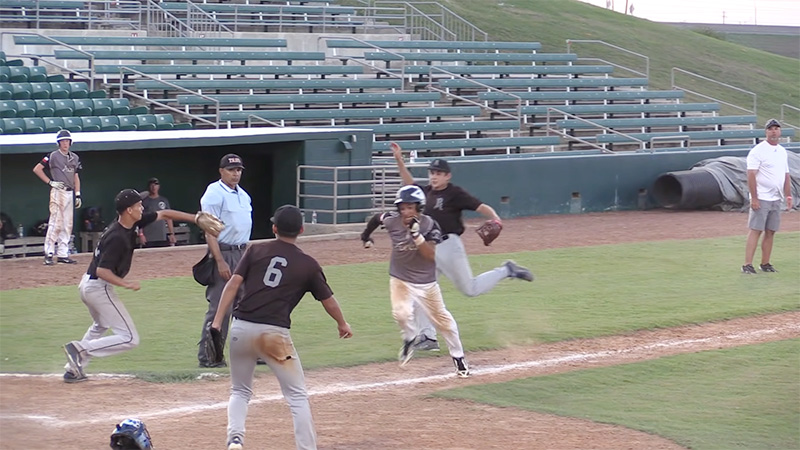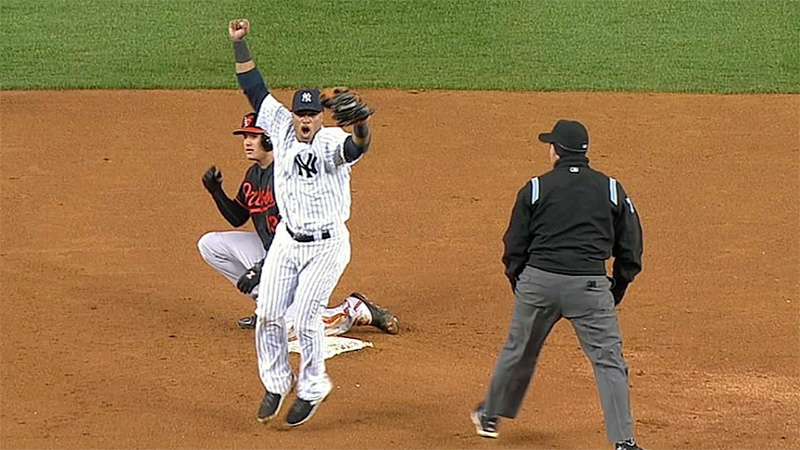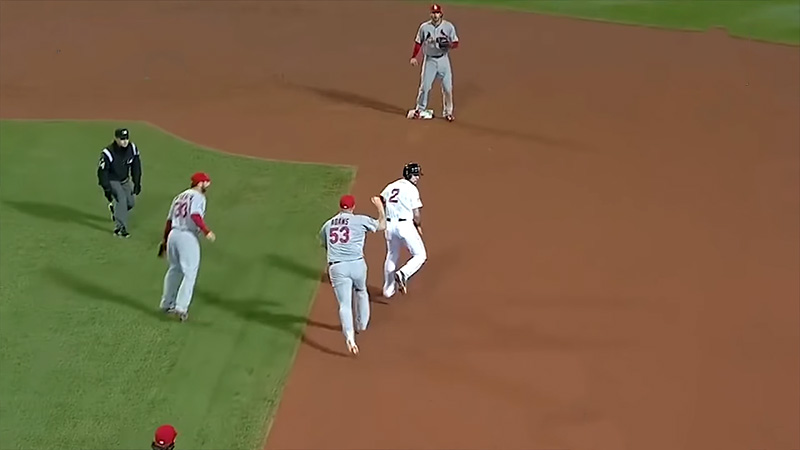Baseball, known as America’s pastime, is a sport filled with unique terms and intriguing situations. One such situation is the pickle, an informal name for the scenario when a baserunner is caught between two bases and faces the risk of being tagged out.
The pickle, also referred to as the hotbox, showcases the strategic battle between the baserunner and the fielders, testing their agility, decision-making, and teamwork.
This captivating aspect of the game brings excitement and tension to both players and spectators alike. The dynamics of a pickle involve quick movements, strategic maneuvers, and the potential for game-changing moments.
In this article, we will deal with the world of pickles in baseball, exploring the strategies employed, notable examples from history, and the overall impact of these thrilling rundowns on the game itself.
What is the Term “Pickle” in Baseball?
The term “pickle” in baseball rundowns comes from the image of a trapped pickle in a jar or brine. When a baserunner is caught between bases, they resemble a confined pickle, highlighting their predicament.
Like a pickle, the baserunner remains uncertain until tagged out or successfully escaping. The situation is informally called a “pickle” or “hotbox,” adding familiarity and lightheartedness. These terms reflect the unique language and culture of baseball, emphasizing a shared understanding.
Comparing the baserunner to a pickle adds color and depth to the game, capturing its intensity. “Pickle” and “hotbox” have become ingrained in baseball’s vocabulary, contributing whimsy to the strategic nature of the sport.
The Situation of a Pickle in Baseball
Some possible situations of a pickle in baseball are briefly discussed in the following section. Please get through them with a cautious mind.
Baserunner Stranded Between Two Bases
In a baseball game, a pickle occurs when a baserunner finds themselves caught in a precarious situation between two bases. This can happen for a variety of reasons, such as a miscommunication between baserunners or a fielding error by the defense.
When a baserunner is stranded, they are unable to advance to the next base safely and are essentially stuck in a no man’s land.
In Jeopardy of Being Tagged Out
Being caught in a pickle puts the baserunner at great risk of being tagged out by the fielding team. The defensive players recognize the opportunity to make a play and attempt to close off the baserunner’s path to either base.
The baserunner must be agile, quick-thinking, and strategic in order to avoid being tagged out. Their primary goal is to escape the pickle and return safely to a base before the defense can make the tag.
Fielders Trying to Make a Play
When a pickle situation arises, the fielding team sees an opportunity to execute a successful defensive play. They work together to cut off the baserunner’s path and create a situation where they can make the tag.
Fielders must coordinate their movements, communicate effectively, and maintain awareness of the baserunner’s positioning and actions. They aim to pressure the baserunner into making a mistake that will allow them to tag them out.
During a pickle, the baserunner must rely on agility, speed, and decision-making to outsmart the fielders and escape the predicament. Meanwhile, the fielders must work cohesively as a team to apply pressure and prevent the baserunner from reaching a base safely.
The pickle situation adds excitement and intensity to the game, showcasing the strategic elements and athleticism involved in the sport of baseball.
The Dynamics of a Pickle in Baseball

There are some dynamics of a pickle in baseball. Take a look at the mentioned below for a broader understanding.
Baserunner’s Objective
In a pickle situation, the baserunner’s primary objective is to escape the fielders’ grasp and safely reach a base. They must employ various techniques to deceive and outmaneuver the fielders.
This involves using quick movements, change of direction, and speed to create confusion and make it challenging for the fielders to tag them out. The baserunner needs to be aware of the fielders’ positioning, anticipate their movements, and exploit any gaps or opportunities that may arise.
Their ultimate goal is to buy enough time and create a window of opportunity to safely reach a base and avoid being tagged out.
Fielders’ Objective
The fielders in a pickle situation are tasked with closing off the baserunner’s path and applying pressure to make a successful tag. They must work together as a cohesive unit, communicating effectively and executing coordinated movements to trap the baserunner.
Fielders strategically position themselves, anticipating the baserunner’s moves and cutting off potential escape routes. They aim to force the baserunner into making mistakes or taking risks that will increase the likelihood of a tag-out.
Fielders need to exhibit agility, speed, and precise timing in their movements to successfully execute the tag and secure an out.
Quick Movements and Strategic Decisions Involved
Both the baserunner and the fielders must make split-second decisions and react quickly to the changing dynamics of a pickle. The baserunner must assess the fielders’ positioning and movements in real-time, making strategic decisions on when to accelerate, change direction, or deceive the fielders.
They must be agile and think on their feet to create opportunities for escape. On the other hand, fielders must analyze the baserunner’s actions, communicate with teammates, and adjust their positioning and movements accordingly.
Quick reflexes and sound judgment are essential for both the baserunner and the fielders to succeed in the dynamic and fast-paced environment of a pickle.
The dynamics of a pickle create an exhilarating and suspenseful moment in a baseball game, where athleticism, strategy, and split-second decision-making come together.
Examples and Famous Pickles in Baseball

Here, we have mentioned some famous examples of pickles in baseball. Check them out below.
Notable Pickles in Baseball History
Throughout the rich history of baseball, there have been several notable pickles that have become iconic moments in the sport. These pickles often involve remarkable displays of athleticism, strategy, and quick thinking.
One example is the famous “Bobby Thomson Shot Heard ‘Round the World” in 1951, where Thomson’s home run secured the National League pennant for the New York Giants in a season-deciding game against the Brooklyn Dodgers.
The play included a memorable pickle between baserunner Eddie Stanky and Dodgers’ first baseman Gil Hodges, showcasing the intensity and drama of a high-stakes rundown situation.
Memorable Moments and Strategies Used
In these notable pickles, various strategies and tactics have been employed by both the baserunner and the fielders. Baserunners often use deceptive moves such as feints, jukes, and sudden changes in direction to confuse the fielders and create opportunities for escape.
They may also employ slides, dives, or evasive maneuvers to avoid tags. Fielders, on the other hand, employ coordinated movements, effective communication, and strategic positioning to cut off the baserunner’s path and execute a successful tag.
These strategies are often combined with quick reflexes and instinctive decision-making, resulting in thrilling and unforgettable moments on the baseball field.
Impact on the Outcome of Games with Famous Pickles
The outcome of a pickle can have a significant impact on the outcome of a game. A successful escape by the baserunner can shift momentum and energize the offensive team, leading to potential runs being scored.
The intensity and pressure of a pickle situation heighten the stakes and add an element of suspense to the game, as the outcome of the rundown can have direct implications on the final result.
The impact of these pickles extends beyond the immediate play, shaping the trajectory of the game itself.
Notable pickles in baseball history, memorable moments and strategies used, and the impact on the outcome of games all demonstrate the significance and enduring legacy of these rundown situations.
They showcase the unique blend of athleticism, strategy, and decision-making that makes pickles a captivating aspect of baseball that fans remember and celebrate for years to come.
Pickle Strategies and Techniques in Baseball
These aspects of pickle strategies and techniques in baseball play a huge role in the game. So, take a close look at them below.
Fielding Tactics to Trap the Baserunner
Fielders employ a range of tactics to effectively trap the baserunner in a pickle. One common strategy is the “wheel play,” where fielders execute a quick and coordinated rotation to cut off the baserunner’s path between bases.
Fielders may also use a combination of quick throws and agile footwork to create a “pickle sandwich,” surrounding the baserunner and minimizing their escape options.
Additionally, fielders strategically position themselves to anticipate the baserunner’s moves, often blocking the direct route to the base and forcing the baserunner into making a risky decision.
Baserunner Strategies to Escape the Pickle
Baserunners caught in a pickle situation employ various strategies to escape the fielders’ grasp. One common technique is the “stop-and-go,” where the baserunner deceives the fielders by suddenly stopping, then quickly changing direction to catch the fielders off guard.
Baserunners may also attempt to extend the pickle by intentionally running back and forth between bases, hoping to tire out the fielders or create a distraction.
Quick reflexes, agility, and the ability to read the fielders’ movements are crucial for baserunners to execute successful escapes.
Role of Communication and Teamwork Among Fielders
Effective communication and teamwork among fielders are essential in successfully executing a pickle. Fielders must communicate their intentions, such as who will cover which base or when to make a throw, to avoid confusion and ensure coordinated movements.
They must also rely on each other to maintain proper positioning and provide support when executing tag attempts. Clear communication and a shared understanding of defensive strategies enhance the fielders’ ability to trap the baserunner effectively.
Additionally, fielders need to trust and rely on their teammates’ abilities to make split-second decisions and execute precise throws to complete the pickle.
The strategies and techniques used in pickles highlight the dynamic nature of the game of baseball. Both fielders and baserunners must possess agility, quick thinking, and the ability to adapt in high-pressure situations.
These tactics, combined with effective communication and teamwork among fielders, contribute to the captivating and strategic aspects of pickles in baseball.
Impact of a Pickle on the Game
Pickles play a crucial role in baseball. The impacts are quite game-changing. So, go through the following part of the article with a sharp mind.
Momentum Shifts and Game-changing Moments
Pickles in baseball have the potential to create significant momentum shifts and game-changing moments. A successful escape by the baserunner can inject energy into the offensive team, demoralize the defensive team, and shift the momentum of the game.
It can lead to increased confidence and motivation among the offensive players, potentially resulting in runs being scored and altering the course of the game.
Conversely, a successful tag by the fielders can provide a crucial out, deflate the offensive team’s morale, and swing the momentum in favor of the defensive team.
These pivotal moments within pickles can have a lasting impact on the flow and outcome of the game.
Excitement and Tension for Players and Spectators
Pickles generate excitement and tension both for the players directly involved and for the spectators watching the game. The strategic maneuvers, split-second decision-making, and athletic prowess displayed during a pickle create a thrilling and suspenseful atmosphere.
Players must perform under pressure, showcasing their skills and composure amidst the high-stakes situation. The anticipation and uncertainty surrounding the outcome of a pickle engage spectators, keeping them on the edge of their seats as they eagerly follow the back-and-forth struggle between the baserunner and the fielders.
It is these moments of heightened excitement and tension that contribute to the allure of baseball.
Importance of Skill and Decision-making in Pickles
Pickles highlight the importance of skill and decision-making in baseball. Both baserunners and fielders must possess a combination of physical abilities and mental acuity to navigate the complexities of a pickle successfully.
Baserunners rely on their agility, speed, and deceptive moves to outwit the fielders and escape the rundown. They must make split-second decisions based on the fielders’ movements and positioning.
Fielders, on the other hand, must exhibit quick reflexes, precise timing, and strategic decision-making to execute successful tags and prevent the baserunner from escaping.
The skill and decision-making involved in pickles underscore the strategic nature of the game and the importance of individual and team performance.
The impact of pickles on the game of baseball is multifaceted. From momentum shifts and game-changing moments to the excitement and tension experienced by players and spectators, pickles add an element of unpredictability and drama to the sport.
They showcase the skill, athleticism, and decision-making abilities of the players involved, elevating the strategic and competitive nature of baseball.
Notable Pickles in Baseball History: At A Glance
| Year | Game | Teams Involved | Description |
| 1951 | NL Playoff Game | New York Giants vs. Brooklyn Dodgers | Bobby Thomson hits a game-winning home run in the “Shot Heard ‘Round the World,” involving a memorable pickle between baserunner Eddie Stanky and Dodgers’ first baseman Gil Hodges. |
| 1975 | World Series Game 6 | Boston Red Sox vs. Cincinnati Reds | Carlton Fisk’s iconic home run results in a pickle between Fisk and Reds’ catcher Johnny Bench at home plate, showcasing a dramatic and intense rundown. |
| 1992 | World Series Game 6 | Toronto Blue Jays vs. Atlanta Braves | In a pivotal game, Dave Winfield’s game-winning double leads to a pickle between baserunner Otis Nixon and Blue Jays’ third baseman Kelly Gruber, culminating in a critical tag and out. |
| 2011 | World Series Game 6 | St. Louis Cardinals vs. Texas Rangers | A crucial pickle occurs between baserunner Ian Kinsler and Cardinals’ first baseman Albert Pujols, resulting in an intense tag attempt and setting the stage for a game-deciding play. |
| 2020 | NL Wild Card Series | Los Angeles Dodgers vs. San Diego Padres | Fernando Tatis Jr.’s daring baserunning creates an exciting pickle between him and Dodgers’ infielders, showcasing his agility and the fielders’ quick reactions. |
FAQs
Are pickles only limited to rundown situations in baseball?
No, the term “pickle” is primarily associated with rundown situations in baseball, but it can also be used more broadly to describe any situation where a baserunner is trapped between two bases and in jeopardy of being tagged out.
The term is often used interchangeably with “rundown” or “hotbox.”.
How do fielders communicate during a pickle?
Communication among fielders is crucial during a pickle to ensure coordination and avoid confusion. Fielders often use verbal cues, such as calling out the baserunner’s location or signaling which base to cover.
Non-verbal communication, such as hand gestures or eye contact, is also essential in conveying intentions and coordinating movements. Clear and effective communication enhances the fielders’ ability to execute successful rundown strategies.
Can a baserunner go back to their original base during a pickle?
Yes, a baserunner caught in a pickle can attempt to go back to their original base in an effort to confuse or tire out the fielders. This tactic is often employed to create opportunities for escape or to draw a throw, potentially allowing a teammate to advance to the next base.
However, going back and forth between bases carries risks, as the fielders can quickly react and execute a tag if the baserunner is not careful.
How do baserunners strategize to escape pickles?
Baserunners in a pickle situation employ various strategies to try to elude the fielders. They may use deceptive moves like sudden stops, changes of direction, or slides to confuse the fielders and create opportunities to escape.
Baserunners also rely on their agility and speed to quickly change direction or execute evasive maneuvers. Reading the fielders’ movements, anticipating throws, and timing their moves are key elements in baserunners’ strategies to escape pickles.
Wrapping Up
The pickle, or the situation in which a baserunner is stranded between two bases and in jeopardy of being tagged out, is a fascinating and dynamic aspect of baseball.
It showcases the strategic decision-making, skill, and athleticism of both the baserunners and the fielders involved. Pickles have the potential to create game-changing moments, shifting momentum and adding excitement to the sport.
They require quick thinking, coordination, and effective communication among fielders to execute successful rundowns and tags.
The impact of pickles extends beyond the game, engaging spectators and contributing to the unpredictable and captivating nature of baseball. Thank you so much.







